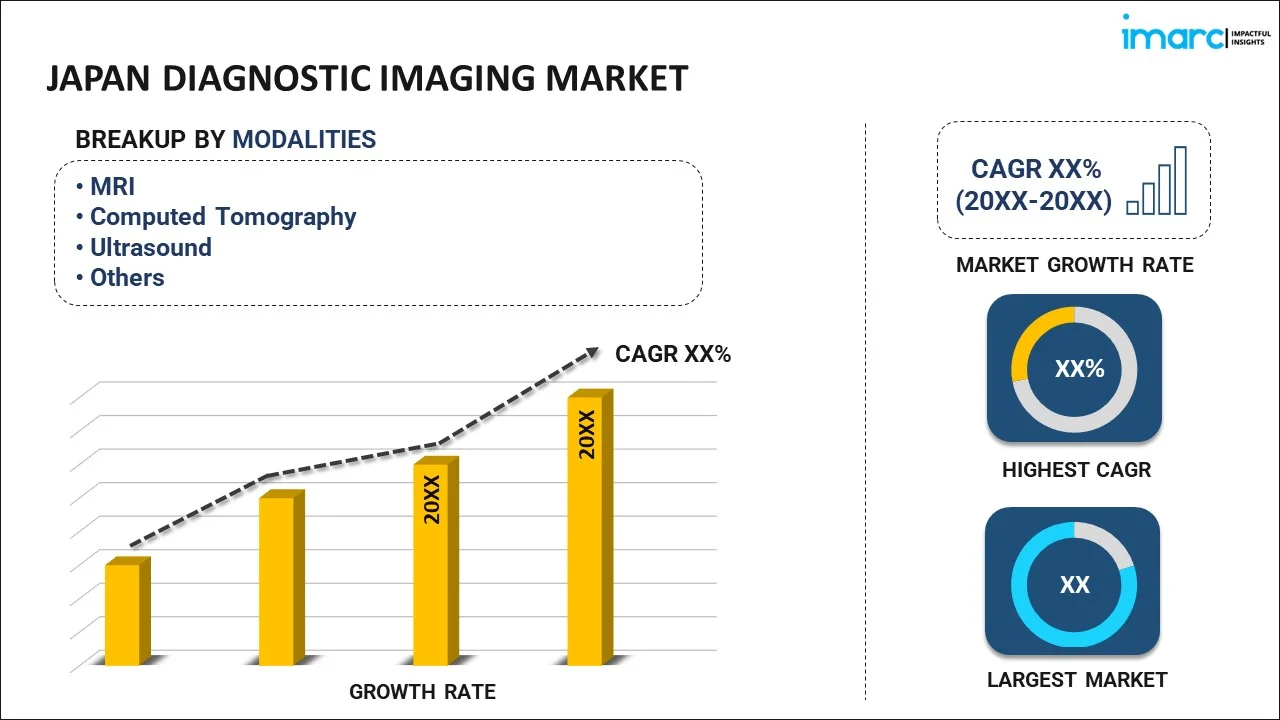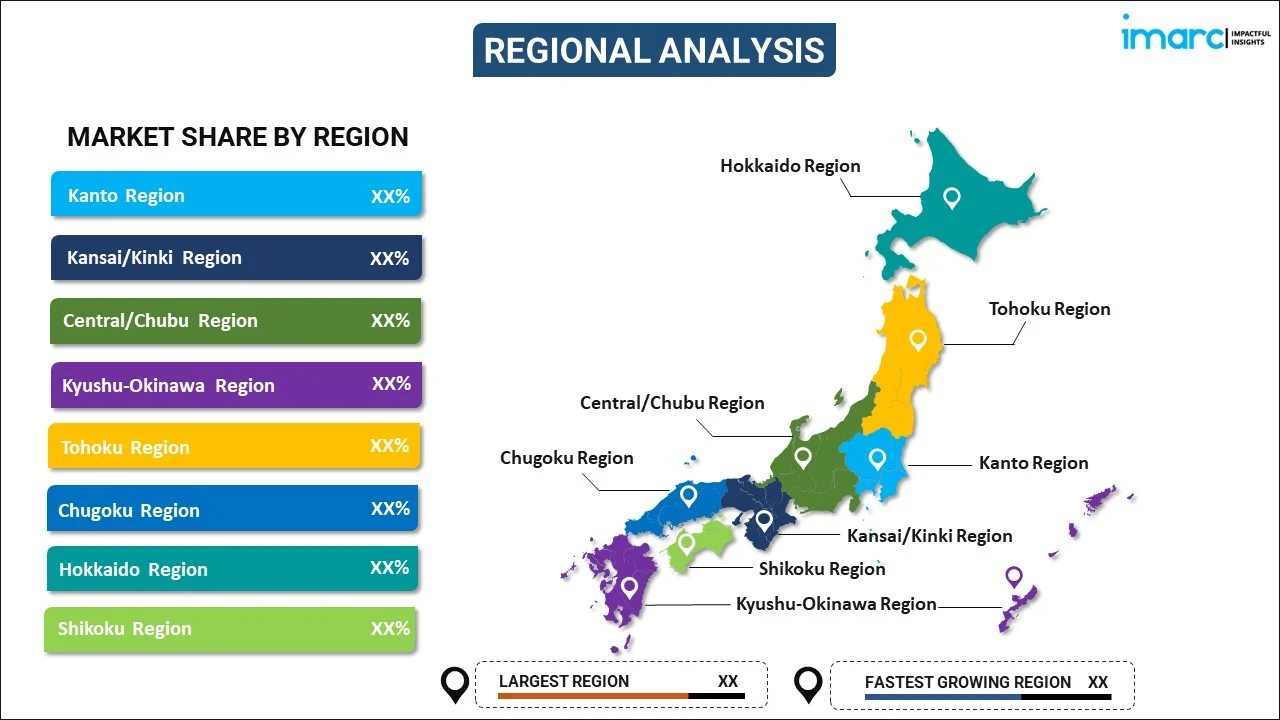
Japan Diagnostic Imaging Market Report by Modality (MRI, Computed Tomography, Ultrasound, X-Ray, Nuclear Imaging, Fluoroscopy, Mammography), Application (Cardiology, Oncology, Neurology, Orthopedics, Gastroenterology, Gynecology, and Others), End User (Hospitals, Diagnostic Centers, and Others), and Region 2025-2033
Market Overview:
Japan diagnostic imaging market size reached USD 1.3 Billion in 2024. Looking forward, IMARC Group expects the market to reach USD 2.1 Billion by 2033, exhibiting a growth rate (CAGR) of 5.6% during 2025-2033. Advancements in MRI technologies, significant developments in CT scanners, and innovations in ultrasound and nuclear medicine, tailored to provide superior imaging solutions, are primarily driving the market growth.
|
Report Attribute
|
Key Statistics
|
|---|---|
|
Base Year
|
2024 |
|
Forecast Years
|
2025-2033 |
|
Historical Years
|
2019-2024
|
| Market Size in 2024 | USD 1.3 Billion |
| Market Forecast in 2033 | USD 2.1 Billion |
| Market Growth Rate (2025-2033) | 5.6% |
Diagnostic imaging stands as a revolutionary pillar in the medical sector, providing a non-invasive method that allows clinicians to see inside the body to assess health conditions and guide treatment strategies. It refers to a variety of techniques that visualize structures and activities in the body, transcending the limitations of a standard physical exam. The spectrum of diagnostic imaging incorporates several modalities such as X-rays, computed tomography (CT) scans, magnetic resonance imaging (MRI), ultrasound, and nuclear medicine, each offering distinct insights into the human body. This innovative field has evolved extensively, powered by advancements in technology, leading to enhanced image quality, reduced radiation exposure, and the development of new imaging modalities. It is crucial in the early detection, diagnosis, and treatment of numerous medical conditions, diseases, and injuries, from detecting tumors and fractures to guiding surgical procedures. By offering detailed views of organs, tissues, blood vessels, and bones, diagnostic imaging facilitates informed clinical decisions, enabling timely and targeted intervention, thereby playing an integral role in improving patient outcomes and the overall efficiency of healthcare delivery. It combines medicine, computer science, and technology, continuing to push the boundaries of what is visually discernible in medicine and paving the way for ongoing research and development in medical visualization.
Japan Diagnostic Imaging Market Trends:
The Japan diagnostic imaging market is a pivotal component in the nation's healthcare sector, marked by continual technological advancements and innovations. One of the prominent drivers is the consistent evolution in technology, marked by enhancements in the capabilities of MRI, CT scans, and ultrasound technologies. These are instrumental in providing improved imaging solutions in tandem with the increasing healthcare needs of the populace. The rising health consciousness and a proactive approach towards preventive healthcare and early diagnosis among the Japanese population also act as significant catalysts, propelling the market forward. A conspicuous trend in the market is the integration of Artificial Intelligence (AI) and advanced software in diagnostic imaging equipment. These innovations are pivotal in refining the precision and efficiency of image analysis, thereby facilitating more nuanced and detailed diagnostics. Moreover, the proactiveness of the government in establishing a conducive regulatory environment and the endorsement of technological adoption in healthcare are fostering market growth. Furthermore, the market is characterized by competitive dynamism, with established players focusing on research and development activities aimed at product enhancement, ultimately contributing to the market's expansion and the betterment of healthcare solutions available to the populace in Japan.
Japan Diagnostic Imaging Market Segmentation:
IMARC Group provides an analysis of the key trends in each segment of the market, along with forecasts at the country level for 2025-2033. Our report has categorized the market based on modality, application, and end user.
Modality Insights:

- MRI
- Computed Tomography
- Ultrasound
- X-Ray
- Nuclear Imaging
- Fluoroscopy
- Mammography
The report has provided a detailed breakup and analysis of the market based on the modality. This includes MRI, computed tomography, ultrasound, x-ray, nuclear imaging, fluoroscopy, and mammography.
Application Insights:
- Cardiology
- Oncology
- Neurology
- Orthopedics
- Gastroenterology
- Gynecology
- Others
A detailed breakup and analysis of the market based on the application have also been provided in the report. This includes cardiology, oncology, neurology, orthopedics, gastroenterology, gynecology, and others.
End User Insights:
- Hospitals
- Diagnostic Centers
- Others
The report has provided a detailed breakup and analysis of the market based on the end user. This includes hospitals, diagnostic centers, and others.
Regional Insights:

- Kanto Region
- Kansai/Kinki Region
- Central/ Chubu Region
- Kyushu-Okinawa Region
- Tohoku Region
- Chugoku Region
- Hokkaido Region
- Shikoku Region
The report has also provided a comprehensive analysis of all the major regional markets, which include Kanto Region, Kansai/Kinki Region, Central/ Chubu Region, Kyushu-Okinawa Region, Tohoku Region, Chugoku Region, Hokkaido Region, and Shikoku Region.
Competitive Landscape:
The market research report has also provided a comprehensive analysis of the competitive landscape. Competitive analysis such as market structure, key player positioning, top winning strategies, competitive dashboard, and company evaluation quadrant has been covered in the report. Also, detailed profiles of all major companies have been provided. Some of the key players include:
- Canon Medical Systems Corporation (Canon Inc.)
- Carestream Health
- Esaote SpA
- FUJIFILM Corporation
- GE Healthcare
- Hologic, Inc.
- Koninklijke Philips N.V.
- Shimadzu Corporation
- Siemens Healthineers AG (Siemens AG)
(Please note that this is only a partial list of the key players, and the complete list is provided in the report.)
Japan Diagnostic Imaging Market Report Coverage:
| Report Features | Details |
|---|---|
| Base Year of the Analysis | 2024 |
| Historical Period | 2019-2024 |
| Forecast Period | 2025-2033 |
| Units | Billion USD |
| Scope of the Report | Exploration of Historical Trends and Market Outlook, Industry Catalysts and Challenges, Segment-Wise Historical and Future Market Assessment:
|
| Modalities Covered | MRI, Computed Tomography, Ultrasound, X-Ray, Nuclear Imaging, Fluoroscopy, Mammography |
| Applications Covered | Cardiology, Oncology, Neurology, Orthopedics, Gastroenterology, Gynecology, Others |
| End Users Covered | Hospitals, Diagnostic Centers, Others |
| Regions Covered | Kanto Region, Kansai/Kinki Region, Central/ Chubu Region, Kyushu-Okinawa Region, Tohoku Region, Chugoku Region, Hokkaido Region, Shikoku Region |
| Companies Covered | Canon Medical Systems Corporation (Canon Inc.), Carestream Health, Esaote SpA, FUJIFILM Corporation, GE Healthcare, Hologic, Inc., Koninklijke Philips N.V., Shimadzu Corporation, Siemens Healthineers AG (Siemens AG), etc. |
| Customization Scope | 10% Free Customization |
| Post-Sale Analyst Support | 10-12 Weeks |
| Delivery Format | PDF and Excel through Email (We can also provide the editable version of the report in PPT/Word format on special request) |
Key Questions Answered in This Report:
- How has the Japan diagnostic imaging market performed so far and how will it perform in the coming years?
- What has been the impact of COVID-19 on the Japan diagnostic imaging market?
- What is the breakup of the Japan diagnostic imaging market on the basis of modality?
- What is the breakup of the Japan diagnostic imaging market on the basis of application?
- What is the breakup of the Japan diagnostic imaging market on the basis of end user?
- What are the various stages in the value chain of the Japan diagnostic imaging market?
- What are the key driving factors and challenges in the Japan diagnostic imaging?
- What is the structure of the Japan diagnostic imaging market and who are the key players?
- What is the degree of competition in the Japan diagnostic imaging market?
Key Benefits for Stakeholders:
- IMARC’s industry report offers a comprehensive quantitative analysis of various market segments, historical and current market trends, market forecasts, and dynamics of the Japan diagnostic imaging market from 2019-2033.
- The research report provides the latest information on the market drivers, challenges, and opportunities in the Japan diagnostic imaging market.
- Porter's five forces analysis assist stakeholders in assessing the impact of new entrants, competitive rivalry, supplier power, buyer power, and the threat of substitution. It helps stakeholders to analyze the level of competition within the Japan diagnostic imaging industry and its attractiveness.
- Competitive landscape allows stakeholders to understand their competitive environment and provides an insight into the current positions of key players in the market.
Need more help?
- Speak to our experienced analysts for insights on the current market scenarios.
- Include additional segments and countries to customize the report as per your requirement.
- Gain an unparalleled competitive advantage in your domain by understanding how to utilize the report and positively impacting your operations and revenue.
- For further assistance, please connect with our analysts.
 Inquire Before Buying
Inquire Before Buying
 Speak to an Analyst
Speak to an Analyst
 Request Brochure
Request Brochure
 Request Customization
Request Customization




.webp)




.webp)












